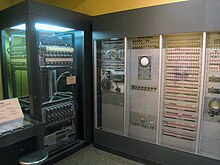
Back Уърлуинд I Bulgarian Whirlwind (ordinador) Catalan Whirlwind German Whirlwind Spanish Whirlwind I Finnish Whirlwind I French Whirlwind (computer) Italian Whirlwind Japanese 훨윈드 I Korean Whirlwind I Polish
 Whirlwind computer elements: core memory (left) and operator console | |
| Product family | "Whirlwind Program"[1]/"Whirlwind Project"[2] |
|---|---|
| Generation | 1st |
| Release date | April 20, 1951 |
| CPU | 16 bits, parallel. Uses about 5000 vacuum tubes |
| Memory | Core memory, 1 kiloword of 16 bits words (2 kilobytes). Ultimately 2048 words (4KB). |
| Power | More than 100 kW |
| Dimensions | 2,000 sq.ft (185 m2) |
| Mass | 20,000 lbs (9.1t) |
| Successor | TX-0, TX-2, DEC PDP-1 |
Whirlwind I was a Cold War-era vacuum-tube computer developed by the MIT Servomechanisms Laboratory for the U.S. Navy. Operational in 1951, it was among the first digital electronic computers that operated in real-time for output, and the first that was not simply an electronic replacement of older mechanical systems.
It was one of the first computers to calculate in bit-parallel (rather than bit-serial), and was the first to use magnetic-core memory.
Its development led directly to the Whirlwind II design used as the basis for the United States Air Force SAGE air defense system, and indirectly to almost all business computers and minicomputers in the 1960s,[3] particularly because of the mantra "short word length, speed, people."[4]
- ^ Redmond, Kent C.; Smith, Thomas M. (1980). Project Whirlwind: The History of a Pioneer Computer. Bedford, MA: Digital Press. ISBN 0-932376-09-6. Retrieved 2012-12-31.
- ^ "Compaq donates historic SAGE, Whirlwind artifacts to museum". MITnews. September 26, 2001. Retrieved 2013-08-12.
- ^ "IBM Benefits from the Cold War". Grace Hopper and the Invention of the Information Age. Book Baby. 2015.
- ^ Larry Watkins (May 1982). "A DEC History of Minicomputers". Hardcopy. pp. 12–19.
Of these, speed is the least important factor from a historical standpoint .. people are a very important factor .. Ken Olsen .. Ben Gurley
© MMXXIII Rich X Search. We shall prevail. All rights reserved. Rich X Search